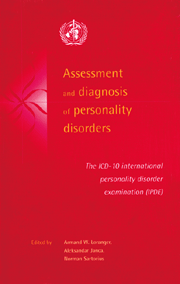 Assessment and Diagnosis of Personality Disorders
Assessment and Diagnosis of Personality Disorders Book contents
- Frontmatter
- Contents
- Contributors
- Preface
- Acknowledgements
- I Background and Field Trial
- Background
- Problems in the field of personality disorders
- Review of diagnostic instruments for the assessment of personality disorders
- Epidemiology of DSM-III personality disorders in the community and in clinical populations
- International personality disorder examination (IPDE)
- Experiences with the IPDE
- Field Trial
- II International personality disorder examination (IPDE) ICD-10 module
- Index
Problems in the field of personality disorders
from Background
Published online by Cambridge University Press: 04 August 2010
- Frontmatter
- Contents
- Contributors
- Preface
- Acknowledgements
- I Background and Field Trial
- Background
- Problems in the field of personality disorders
- Review of diagnostic instruments for the assessment of personality disorders
- Epidemiology of DSM-III personality disorders in the community and in clinical populations
- International personality disorder examination (IPDE)
- Experiences with the IPDE
- Field Trial
- II International personality disorder examination (IPDE) ICD-10 module
- Index
Summary
When the World Health Organization/US Alcohol, Drug Abuse and Mental Health Administration (WHO/ADAMHA) decided to conduct the International Pilot Study of Personality Disorders (IPSPD), they entered one of the most controversial fields of mental disorders. Many psychiatrists have doubted the validity of personality disorders (PDs) and their diagnostic reliability has been found to be very low. Theories of their etiology have implicated constitution, genes, brain abnormalities, bad morals, poor environment, and disturbed psychological development. There are no generally accepted treatments for PDs, and their long-term outcome is often unknown. Since the introduction of DSM-III in 1980, however, empirical studies of PDs have flourished. The research has brought into focus many of the problems related to PDs. This chapter will describe some of them, and try to place the IPSPD and IPDE (International Personality Disorder Examination) within that context.
Basic descriptions of personality
Throughout history attempts have been made to identify the basic dimensions or categories that best define the essential similarities and differences among people. Hippocrates identified four basic temperaments based on the balance of the body fluids. The phrenologists stated that they were able to identify personality characteristics through the contour variations of the skull. Kretschmer and Sheldon described personality features based on physique, and believed that these personality types predisposed to the major mental disorders. In 1908 Heyman and Wiersma statistically analyzed the personality traits of a great number of ordinary people, and they found that personality could be described by three orthogonal factors.
- Type
- Chapter
- Information
- Assessment and Diagnosis of Personality DisordersThe ICD-10 International Personality Disorder Examination (IPDE), pp. 3 - 9Publisher: Cambridge University PressPrint publication year: 1997
- 3
- Cited by


